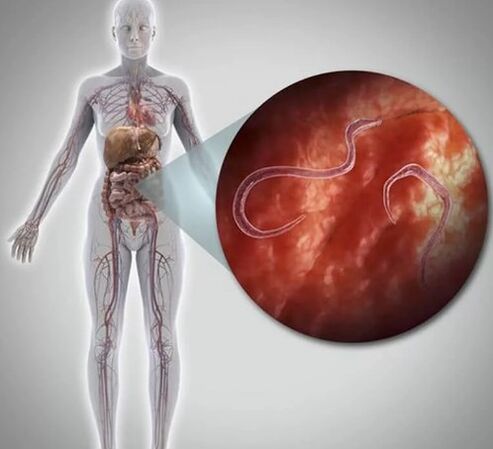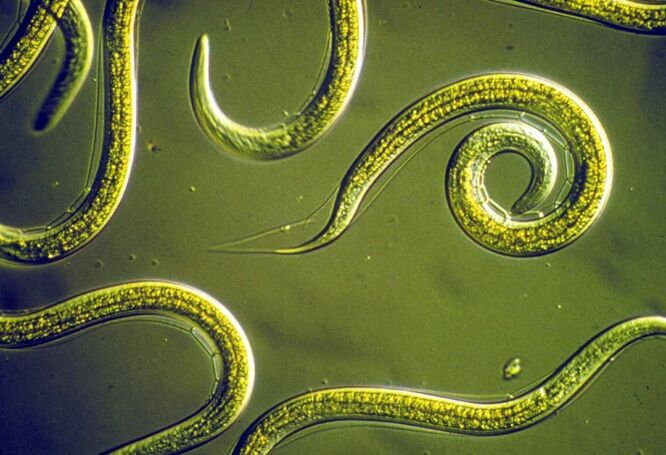Human parasites are parasites, the infection of which is subject to a person. The general definition of the word "parasite" applies not only to multicellular and protozoa, living at the expense of their owner and to the detriment of the latter, but also viruses, bacteria and mushrooms with similar qualities. According to historical tradition, and from the point of view of medical parasitology, it is customary to call any creatures leading a parasitic lifestyle, except for viruses and bacteria with similar qualities.

Parasites include many helminths, fungi, viruses, protozoa, worms, crustaceans, spider -shaped, insects. The owners of parasites can be bacteria, simplest, plants, animals and humans. Parasites undergo a complex development cycle: sometimes they need a change of 2-3 owners whose body is intermediate (helminths pass the larval stages) or final (helminths become invasive).
From history:
The study of parasites in ancient people is based on the study of feces and other petrified material. The earliest parasites found in man were Paragonimus Westermani eggs from the northern chile, discovered in the hardened feces, and dated approximately 5900 BC. e. In Brazil, Hookworm eggs from 5000 BC were also found. e. , in Peru - nematod eggs from 2330 BC. e. And the Egyptian mummies dating back to 2000, 1250, and 1000 years. BC. e. They contained a soliter egg, along with a well -preserved female worm.
In Berlin, for the period 1866-1875. 16% of all opened corpses contained worms of worms. Bull Taperly (Taeniarhynchus saginatus) was especially widespread where the raw cattle meat was eaten. In St. Petersburg, according to Kessler, 3. 66 % of the persons investigated by him suffered from this parasite (1888). Pork Tekenia (Taenia Solium) is found everywhere in areas where they eat raw or semi-raw pork meat. In St. Petersburg at the end of the 19th century, about 3 % of the population suffered from this parasite. When they began to avoid the use of raw meat, the percentage of diseases decreased extremely, for example, in Denmark from 53 % to 20 % for 10-12 years. Dypilidium Caninum lives in the intestines of dogs and cats, and rarely in the intestines of children. Cases of infection of children at the end of the 19th century were known from England, Germany, Denmark: infection occurs exclusively when fleas swallowed.
Parasites and their discharge(products of their life) are the strongest poisons for the human body. They cause severe acidification and thickening of blood and the entire internal environment. They provoke the most serious health disorders. From bronchitis to oncology. Destroy the psyche of a person, deprive of peace and sleep. In the child’s body, parasites prevent the normal development of the nervous system of the child and, with a long current disease, contribute to mental and physical backwardness.
Classification
By distribution:

- Ubiquette - meet everywhere.
- Tropical - distributed in tropical climatic zones.
On biological and epidemiological features:
- Geohelminths is a disease in which helminths first develop in the human body, and then on non -living substrate, more often in the Earth.
- Biohelminths is a disease in which a biological cycle of helminth development must take place in the body of other living beings, except for a person. Distinguish between the final owners, in the body of which helminths develop to the sexually mature stage, as well as intermediate ones, where the parasite is in the stage of the larva or its reproduction is not sexually. A person is more often the final owner, less often - intermediate.
- Contact helminthiasis is a disease in which parasites are distinguished from the human body mature or almost mature, as a result of which the infection of another person is possible or re-infection of himself (auto-invasion, re-invasion).
Depending on the localization of the parasite in the body:
- Enlightenment - living in the cavity of the intestines and other cavities of a person (for example, ascarides, ribbons).
- Fabric - living in fabrics (Sistematis, Ehinokokkoz).
At the place of stay on the owner:
- External: mosquitoes, blind, leeches, lice.
- Internal(helminthias):Round worms(Nematodes - Ascarids, Filaria, Vlasov, pinworms, strungyloids, Ancylostomidae, Trichinella);Flat worms:
- Trematodes (saucers - cat bickelter (Opisthorchis), Cloner, Fasciola, Schistosomes);
- Cestodes (ribbon worms - bull and pork tapeworm, dwarf tanning, wide tape, echinococcus).
- Bacteriosis(Leptospira, staphylococcus, streptococcus, shigella).
- Protosis(amoebas, giardia, trichomonas, often the owners of chlamydia and AIDS virus).
- Mycoses(fungal diseases) - Candida, Cryptococcus, Penicillium.

How do parasites enter the body?
Parasitism can be infected not only through dirty hands. Animal hair is a carrier of worms (ascaride and toxocara), lamblia. Eggs of pinworms that have fallen from wool remain viability for up to 6 months and through dust, toys, carpets, underwear and bedding and hands fall into the food tract. A dog through wet breathing disperses eggs at a distance of 5 meters (cat - up to 3 meters). Fleas of dogs also tolerate worm eggs. Askarid eggs enter the body through poorly washed vegetables, fruits, berries, greens, dirty hands, and are also spread to flies. And incorrectly cooked barbecue or homemade lard is the path of infection with trichinellosis; Poorly salted fish, caviar - opisthorchiasis and wide tape.
So, there are several ways to enter the body:
- alimentary (through infected food, water, dirty hands);
- contact-household (through household items, from infected family members, pets);
- Transmissible (through blood -sucking insects);
- percutaneous, or active (in which the larva penetrates through the skin or mucous membranes during contact with infected soil, when bathing in open reservoirs).
Symptoms of parasites
It is not at all necessary that the infection somehow manifest itself at all. Sometimes a person feels healthy, despite the invasion, thanks to strong immunity. Some individual time he will be healthy. Then, accordingly, the extinction of immunity (a breakdown can occur at any moment stress, surgery, disease) - quiet signals parasite will still begin to serve. This is a urine with a smell, acne on the skin, stubborn coughing with clean lungs, unstable stools with a pungent odor or constipation, gas formation, unpleasant odor from the mouth. The most specific manifestation of the presence of helminths in the body is bruxism (night rattle of teeth). Night salivation, the usual nausea, the perversion of the appetite of night hunger, indefatigable hunger, addiction to sweet and acidic foods, and air belching. Children have a decrease in appetite or electoral appetite. Sometimes people with increased appetite are found, but at the same time they lose weight.
General signs of parasitic invasions
Constipation, stagnation of bile

Some worms, due to their shape and large sizes, can mechanically close the lumen of the intestines, the ducts of the biliary tract, which leads to a deterioration in peristalsis, the formation of constipation, complete or partial intestinal obstruction. Hlybon invasion can provoke the blockage of the common bile duct, which leads to difficulty in the outflow of bile, mechanical jaundice.
Diarrhea
A number of parasites, especially protozoal ones, produce substances similar to prostaglandins, which lead to sodium and chlorides to loss, which, in turn, provokes diarrhea - frequent watery bowel movements.
Gastric and intestinal discomfort syndrome
The parasites living in the upper intestine cause inflammation and lead to disruption of the intestines, bloating. This leads to a decrease in the absorption of nutrients. As a result, fats that should be absorbed in the small intestine fall into the colon, provoking cramps, alternating constipation and diarrhea.
Joint pain and muscles
Parasites can move around the human body in order to settle in the most convenient places, for example, in joint fluid and in the muscles. Fabric inflammation is the result of injuring them with parasites or the body's immune response to their presence. At the same time, a person experiences muscle and joint pain.
Allergy
Parasites can disrupt the normal permeability of the intestinal mucosa, which increases the risk of penetrating large non -digested particles of food into them. This activates the body's immune response - the level of eosinophils - protective blood cells of our body, which contribute to the development of allergic reactions, increases. Parasites cause increased production by the body of immunoglobulin E, which enhances allergic reactions.
Problem skin
Intestinal parasites can cause allergic skin reactions - atopic dermatitis, urticaria, eczema. Most often, inflammatory changes on the skin may be the result of the presence of protozoa microorganisms (lamblia, mushrooms) and opisthorchis.
Changing body weight
Weight fluctuations (both more than normal and less) may be a result of a parasitic disease. Weight reduction is due to the fact that digestion is impaired in the body, since there is an "internal consumer". Obesity is also a consequence of the "robbery" of the human body with helminthic invasion. The feeling of hunger occurs with a sharp drop in blood sugar due to the activity of helminths, their toxic effects on the body.
Anemia
Many types of intestinal helminths are attached to the intestinal wall, damage it, causing a sufficiently greater loss of blood, which leads to anemia.
Nervousness, sleep disturbance
The toxic substances of the vital activity of parasites irritate the central nervous system, causing increased anxiety and nervousness. Frequent awakening in the middle of the night, especially between 2 and 3 hours, is also the result of attempts by the body to get rid of toxic substances through the liver.
"Chronic fatigue syndrome"
"Chronic fatigue syndrome" includes weakness, causeless decrease and fever, emotional instability, loss of concentration and bad memory. These symptoms can be the result of anemia, intoxication, a lack of nutrients in the body caused by parasites.
Having discovered your family members of several symptoms, undergo diagnostics on Parasitism and conduct a preventive treatment course of deworming.

Diagnostics
Recently, the presence of parasites was determined only by the method of duodenal sounding and feces tests using microscopic studies, the purpose of which is to detect selected helminths or their fragments, eggs and larvae. Eggs and larvae of helminths parasitic in the liver, biliary paths, pancreas and duodenum were found in bile and duodenal contents; On the intestinal forms of helminthias, they examined samples of feces; In case of suspicion of Paragonimoz, sputum was investigated, and urine - urine on the genitourinary chistosomosis. But the reliability of these studies depends on the professionalism of the employees - whether the laboratory assistant will notice in the microscopic examination of parasites. In addition, if the parasite did not postpone the eggs at the moment when the check is performed, its presence will be unnoticed even with high qualifications of the laboratory assistant. Often only with 8-10 attempts can you get a positive result.
Today, there are immunological studies that allow you to determine in the blood of an infected person the presence of antigens and antibodies to parasites of various kinds. The reliability of such analyzes depends on the life cycle of parasites and their quantity in the body.
The most vulnerable to the effects of parasites are children. They are infected with various types of parasites through dirty hands, sand, soil and water. Sometimes the infection of the child can occur in intrauterine, since the protozoa, bacteria, viruses, candida and helminth larvae can penetrate the fetus through the placenta with a blood flow, as well as during birth through the birth canal.
Do not risk your children's health, conduct preventive deworming courses.






































